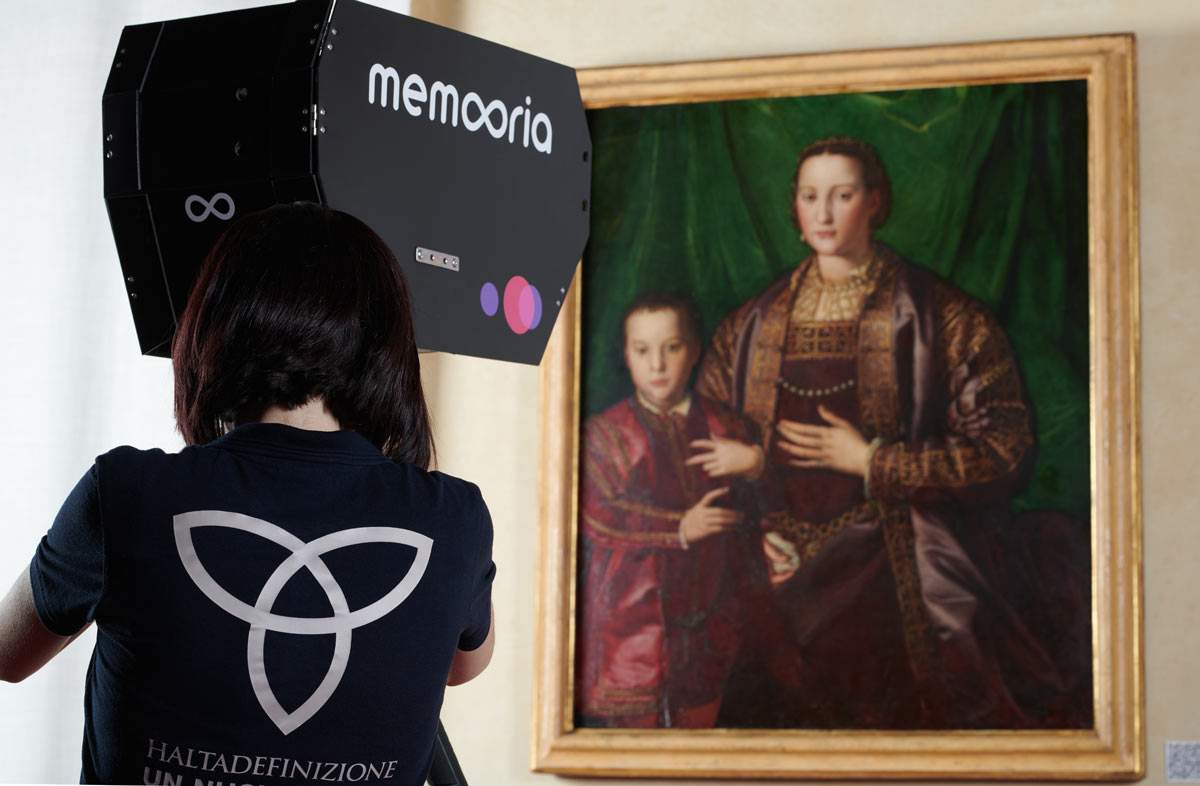The collaboration between the Regional Directorate Museums of Tuscany and the company Haltadefinizione continues: after the digitization of Raphael’s Miracle of the Hanged Men, now comes the ultra-high-definition acquisition of one of the most important works in the Museo Nazionale di Palazzo Reale in Pisa, namely the 1549 itratto di Eleonora di Toledo con il figlio Francesco, attributed to Bronzino (Agnolo di Cosimo di Mariano Tori; Florence, 1503 - 1572): it is a variant of the more famous homologous painting preserved at the Uffizi Gallery.
Bronzino’s portraits symbolize the official portraiture of the Medici Court of Cosimo I, the first Grand Duke of Tuscany, and idealize and codify the haughty, strong-willed and aloof image of his bride Eleonora. In the Palazzo Reale portrait, Eleonora appears in the role of mother with her son Francesco, clad in a crimson red dress, the prerogative color of the grand ducal court. Eleonora appears composed and solemn, with her hair gathered in the center in the pearl-studded scuff and shows off her precious jewelry, including pendant earrings, two rows of pearls, and a magnificent gold girdle, possibly made to a design by Benvenuto Cellini. On her gown, Eleonora wears a zimarra, a richly embroidered surcoat open at the front with sleeves, a type of 16th-century women’s fashion favored by the noblewoman. Her son Francesco, the heir to the grand ducal title, who would build the new Medici residence on the Arno River that now houses the museum, is portrayed at the age of about eight, dressed as an adult, with robes, habit, and pants in red satin, in the tradition of “child princes.” The Spanish style and the openness to international taste would give rise to new criteria of elegance and the flourishing of an unprecedented fashion, influenced by the Grand Duchess’s style, which even today, thanks to excellent pictorial evidence, it is possible to retrace in order to have an immediate vision of the flourishing period that the Medici duchy experienced.
Pisa’s portrait, rich in detail in the rendering of the precious fabrics and pearl jewels that enriched the grand duchess and now, will benefit from gigapixels that will allow a close look at every single detail of the work. In fact, the digitization of art is considered a complementary and fundamental path for the enhancement of the museum heritage, the images of the works in ultra-high definition accompany, deepen the live view of the work by offering viewpoints to the entire audience of enthusiasts, scholars and specialists, students and teachers.
“In the museum of Palazzo Reale,” says director Fabrizio Vallelonga, “Bronzino’s portrait acquires unique significance with the display, in an extraordinary dialogue, of the crimson velvet court dress that probably belonged to Eleonora herself, remarkably similar to the one in the painting. A unique possibility of comparison between an original dress from the mid-sixteenth century and the painting, which we can now admire online in very high definition even in its smallest details.”
“Among the countless elements that connect the two museums in Pisa,” says Stefano Casciu, regional director museums of Tuscany, “Palazzo Reale and San Matteo, which are afferent to the Museums of Tuscany Directorate, the events related to the display of Bronzino’s portrait and the court dress that may have belonged to Eleonora are among the most eloquent. The dress comes, in fact, precisely from the former monastery of San Matteo in Soarta, once adjoining the Medici residence in the city, and once decommissioned had been donated to the nuns of San Matteo who long used it to dress a wooden statue of the Virgin. The display of Bronzino’s dress and portrait, also recovered at the time from the deposits of the San Matteo, is the most accomplished expression of the cultural potential of the two museums and the deep connection with the dynastic events of the Grand Duchy and the historical context of the city.”
“We are happy that the collaboration with the Regional Museums Directorate of Tuscany is continuing,” emphasizes Luca Ponzio, founder of Haltadefinizione, “and that the value of digitization and the opportunities it represents for both the dissemination of art knowledge and the monitoring of the state of the work has been perceived.”
Pictured is one of the moments of digitization.
 |
| Pisa, Royal Palace's portrait of Eleanor of Toledo digitized in very high definition |
Warning: the translation into English of the original Italian article was created using automatic tools. We undertake to review all articles, but we do not guarantee the total absence of inaccuracies in the translation due to the program. You can find the original by clicking on the ITA button. If you find any mistake,please contact us.